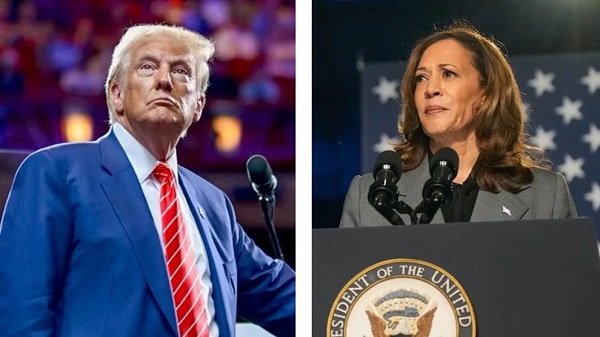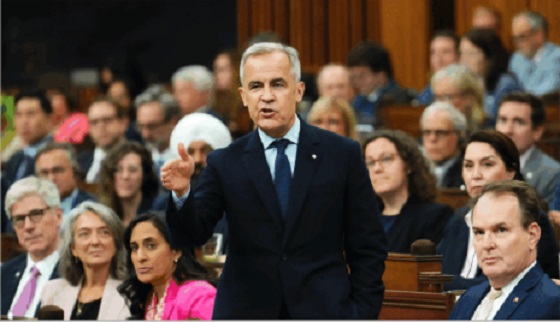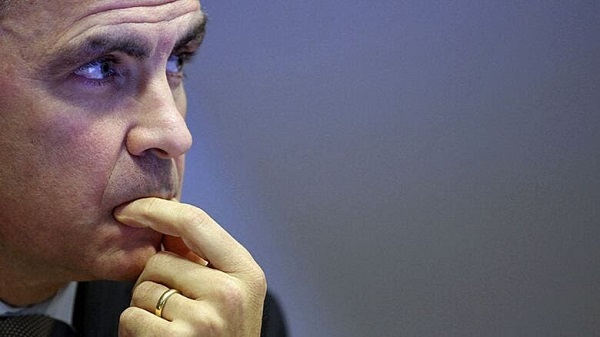Opinion
The majority of voters have moved on from legacy media and legacy narratives

From EnergyNow.ca
By Margareta Dovgal
A Wake-Up Call for Political Strategists Across the Continent
For only the second time in US history, a president has lost, left office, and won re-election. For most Canadians watching the US election, the news of Donald Trump’s impending return to the White House comes with some degree of disappointment – and confusion.
Rather than getting caught up in doomsaying as there’s enough of that going around, I wanted to share some thoughts on what I would hope Canadians working in and around politics and policy come away with.
Speaking to the heart shouldn’t neglect speaking to the wallet
Biden probably should have resigned sooner, and Harris should have gone through a competitive primary race before carrying the flag. Hindsight is 20/20, and I doubt that the Democrats will make those same mistakes twice.
What I do suspect will be harder to shake is the commitment to running campaigns on social issues alone. The Democrats made the gamble that reproductive rights were a persuasive enough ballot box question to distract from Joe Biden’s lacklustre economic performance.
The clear majority of voters showed that they are more concerned with their job security, housing affordability, and tax bills.
The Democrats now have an opportunity to realign with the concerns of working Americans, recognizing that economic anxieties cannot be overlooked. A robust economic approach doesn’t preclude a moderate and fair social approach, but the latter can’t replace the former.
In Canada, this holds true for our discussions around energy and resources. I’m seeing a very similar disconnect play out on resource policy. Patently bad policies with horrible economic impacts are being advanced at all levels by governments more concerned with virtue signalling than ensuring robust economic performance – the federal Emissions Cap and the fantastical ambitions of David Eby’s CleanBC program among them.
Pre-pandemic, vibes-based economic policy seemed to work. In times of plenty, it is easy to persuade voters that taking economic hits is the right thing to do — after all, why worry about the price of something if you can afford it? Anyone still trying that in 2024 has lost the plot.
Affordability remains a paramount issue for many citizens, and the U.S. election highlighted how campaigns that overlook economic concerns and the declining quality of life risk alienating voters.
From groceries to gas prices, the rising cost of living is top of mind for Canadians, and resource policies must reflect this reality. For instance, a balanced approach to energy production can help keep costs reasonable while supporting Canadian jobs and industries.
It’s a reminder that beyond political credibility or mainstream appeal, policies that directly address financial challenges resonate most with the electorate.
For the resource sector, this means recognizing how affordable energy, resilient supply chains, and robust employment opportunities are interconnected with national policy priorities.
Truth and gatekeeping
The gamesmanship over who holds the authority to define “truth” continues in earnest, and engaging in it by discounting mass popular narratives is a risky gambit for any political movement that seeks to maintain widespread relevance.
We’re seeing a generational change, not just in the US but globally, on how people consume and produce media.
I would argue that Elon Musk’s purchase of Twitter was the edge that Trump needed in this new era. Millions of Americans, and millions abroad, sought news and commentary from the platform. Political discourse on the 2024 election was shaped by the ideas generated and amplified online, faster than mainstream news could reliably pick up on.
Since Musk’s acquisition of Twitter/X, the editorial stance, algorithm, and tone of the platform have all shifted. Yes, it has gone ‘rightwards’, but rather than that serving to shrink the audience, it has instead grown, picking up swing voters and rallying the “persuadeds” more effectively.
Just look at the last debate between Trump and Harris: they weren’t even talking about the same political realities.
Research finds that as a main source of news, social media is still behind TV. Where we see the biggest difference is among younger voters.
46% of Americans 18-29 say social media is their top source of news, according to Pew Research. Beyond widespread appeal or readership, social media drives the political commentary of the chattering classes more than any one other platform. TikTok’s influence is likewise growing, with an even younger demographic relying on it almost entirely to help shape and articulate their views.
A similar dynamic around “truth” was plainly obvious in British Columbia’s provincial election last month. A good chunk of commentators couldn’t fathom that voters could accept a party that had refused to throw out candidates saying offensive or dubious things.
The BC Conservatives went from zero seats to just shy of government.
Enough ink has been spilled on this by other commentators, but let’s recap what many have said about the explanatory factors: BC United collapsed following its disastrous rebrand, the BC NDP was stuck with having to account with the inevitable baggage of incumbency in a struggling global economy, and the rise of Poilievre and the federal Conservatives lent some additional name-brand recognition to the BCCP.
The most important piece, in my estimation, was the Conservatives’ ability to tap into a growing demographic that didn’t feel their concerns were reflected in the mainstream political discourse. Twitter was far from the only forum for this, but I think it had a large part to play in cultivating the sense among many voters that consequential narratives were not even remotely being touched on in mainstream media. It gutted voters’ trust in the media, giving the BC Conservatives whose narratives were more effective on social media a decisive advantage.
Public safety is a great example of this. Anyone with eyes and ears who has spent time in Downtown Vancouver in recent years can attest to the visible decline, with visible drug use in public spaces, frequent run-ins with people with severe untreated mental illness yelling at phantoms, and unabashed property crime.
Yet, if we were to believe a great deal of commentators just up until the eve of the election, everything was just fine.
Willful blindness only works when people can’t comment on what they see. But comment they did, and the delayed response to it nearly cost the BC NDP the election.
In a purely practical sense, the increasing role of community-driven sources of information mean that gatekeepers can no longer control the flow of information. And let’s not mince words here: anyone concerned about misinformation is talking about gatekeeping.
Subjecting ideas out there in the commons to scrutiny is necessary. We just can’t take for granted that the outlets themselves will provide that editorial scrutiny directly, if it’s not baked in the platform by design and people are actively choosing to spend time on platforms that have a radical free speech mandate.
It’s time to accept that the train has left the station: persuasiveness needs to be redefined by the mainstream, rather than taking one loss after another and crying foul because the game has changed.
Canadian narratives for Canadian politics
Our closest neighbour and trading partner is the world’s largest economy, and Canadians can’t help but look south for news and ideas. Our own politics often mirror the messages we see in the US, and there’s no use trying to pretend that won’t keep happening.
If we want to avoid falling into the trap of inheriting the dysfunction and divisions that are increasingly defining the political system next door, we have a duty to develop compelling narratives that resonate with the unique needs of Canadians, across the political spectrum.
It’s the definition of insanity to keep trying the same things expecting a different result. Rather than directing anger at voters and political movements who have moved on from old media, if you’re not happy with the result, try meeting them where they are.
And no, this doesn’t mean ceding ground to conspiracy theorists or the fringe. They are only succeeding because a) they are speaking to issues that people decide they care about (like them or not) that are panned by the center and the left, and b) most crucially, there isn’t enough emotionally resonant, persuasive substance being put out to win hearts and minds.
These are not inevitable outcomes. Voter preferences and media technologies are constantly evolving. We need to evolve with them by subjecting our leaders to real scrutiny and demanding better.
Margareta Dovgal is Managing Director of Resource Works. Based in Vancouver, she holds a Master of Public Administration in Energy, Technology and Climate Policy from University College London. Beyond her regular advocacy on natural resources, environment, and economic policy, Margareta also leads our annual Indigenous Partnerships Success Showcase. She can be found on Twitter and LinkedIn.
Business
Canada must address its birth tourism problem

By Sergio R. Karas for Inside Policy
One of the most effective solutions would be to amend the Citizenship Act, making automatic citizenship conditional upon at least one parent being a Canadian citizen or permanent resident.
Amid rising concerns about the prevalence of birth tourism, many Western democracies are taking steps to curb the practice. Canada should take note and reconsider its own policies in this area.
Birth tourism occurs when pregnant women travel to a country that grants automatic citizenship to all individuals born on its soil. There is increasing concern that birthright citizenship is being abused by actors linked to authoritarian regimes, who use the child’s citizenship as an anchor or escape route if the conditions in their country deteriorate.
Canada grants automatic citizenship by birth, subject to very few exceptions, such as when a child is born to foreign diplomats, consular officials, or international representatives. The principle known as jus soli in Latin for “right of the soil” is enshrined in Section 3(1)(a) of the Citizenship Act.
Unlike many other developed countries, Canada’s legislation does not consider the immigration or residency status of the parents for the child to be a citizen. Individuals who are in Canada illegally or have had refugee claims rejected may be taking advantage of birthright citizenship to delay their deportation. For example, consider the Supreme Court of Canada’s ruling in Baker v. Canada. The court held that the deportation decision for a Jamaican woman – who did not have legal status in Canada but had Canadian-born children – must consider the best interests of the Canadian-born children.
There is mounting evidence of organized birth tourism among individuals from the People’s Republic of China, particularly in British Columbia. According to a January 29 news report in Business in Vancouver, an estimated 22–23 per cent of births at Richmond Hospital in 2019–20 were to non-resident mothers, and the majority were Chinese nationals. The expectant mothers often utilize “baby houses” and maternity packages, which provide private residences and a comprehensive bundle of services to facilitate the mother’s experience, so that their Canadian-born child can benefit from free education and social and health services, and even sponsor their parents for immigration to Canada in the future. The financial and logistical infrastructure supporting this practice has grown, with reports of dozens of birth houses in British Columbia catering to a Chinese clientele.
Unconditional birthright citizenship has attracted expectant mothers from countries including Nigeria and India. Many arrive on tourist visas to give birth in Canada. The number of babies born in Canada to non-resident mothers – a metric often used to measure birth tourism – dropped sharply during the COVID-19 pandemic but has quickly rebounded since. A December 2023 report in Policy Options found that non-resident births constituted about 1.6 per cent of all 2019 births in Canada. That number fell to 0.7 per cent in 2020–2021 due to travel restrictions, but by 2022 it rebounded to one per cent of total births. That year, there were 3,575 births to non-residents – 53 per cent more than during the pandemic. Experts believe that about half of these were from women who travelled to Canada specifically for the purpose of giving birth. According to the report, about 50 per cent of non-resident births are estimated to be the result of birth tourism. The upward trend continued into 2023–24, with 5,219 non-resident births across Canada.
Some hospitals have seen more of these cases than others. For example, B.C.’s Richmond Hospital had 24 per cent of its births from non-residents in 2019–20, but that dropped to just 4 per cent by 2022. In contrast, Toronto’s Humber River Hospital and Montreal’s St. Mary’s Hospital had the highest rates in 2022–23, with 10.5 per cent and 9.4 per cent of births from non-residents, respectively.
Several developed countries have moved away from unconditional birthright citizenship in recent years, implementing more restrictive measures to prevent exploitation of their immigration systems. In the United Kingdom, the British Nationality Act abolished jus soli in its unconditional form. Now, a child born in the UK is granted citizenship only if at least one parent is a British citizen or has settled status. This change was introduced to prevent misuse of the immigration and nationality framework. Similarly, Germany follows a conditional form of jus soli. According to its Nationality Act, a child born in Germany acquires citizenship only if at least one parent has legally resided in the country for a minimum of eight years and holds a permanent residence permit. Australia also eliminated automatic birthright citizenship. Under the Australian Citizenship Act, a child born on Australian soil is granted citizenship only if at least one parent is an Australian citizen or permanent resident. Alternatively, if the child lives in Australia continuously for ten years, they may become eligible for citizenship through residency. These policies illustrate a global trend toward limiting automatic citizenship by birth to discourage birth tourism.
In the United States, Section 1 of the Citizenship Clause of the Fourteenth Amendment to the Constitution prescribes that “All persons born or naturalized in the United States, and subject to the jurisdiction thereof, are citizens of the United States and of the State wherein they reside.” The Trump administration has launched a policy and legal challenge to the longstanding interpretation that every person born in the US is automatically a citizen. It argues that the current interpretation incentivizes illegal immigration and results in widespread abuse of the system.
On January 20, 2025, President Donald Trump issued Executive Order 14156: Protecting the Meaning and Value of American Citizenship, aimed at ending birthright citizenship for children of undocumented migrants and those with lawful but temporary status in the United States. The executive order stated that the Fourteenth Amendment’s Citizenship Clause “rightly repudiated” the Supreme Court’s “shameful decision” in the Dred Scott v. Sandford case, which dealt with the denial of citizenship to black former slaves. The administration argues that the Fourteenth Amendment “has never been interpreted to extend citizenship universally to anyone born within the United States.” The executive order claims that the Fourteenth Amendment has “always excluded from birthright citizenship persons who were born in the United States but not subject to the jurisdiction thereof.” The order outlines two categories of individuals that it claims are not subject to United States jurisdiction and thus not automatically entitled to citizenship: a child of an undocumented mother and father who are not citizens or lawful permanent residents; and a child of a mother who is a temporary visitor and of a father who is not a citizen or lawful permanent resident. The executive order attempts to make ancestry a criterion for automatic citizenship. It requires children born on US soil to have at least one parent who has US citizenship or lawful permanent residency.
On June 27, 2025, the US Supreme Court in Trump v. CASA, Inc. held that lower federal courts exceed their constitutional authority when issuing broad, nationwide injunctions to prevent the Trump administration from enforcing the executive order. Such relief should be limited to the specific plaintiffs involved in the case. The Court did not address whether the order is constitutional, and that will be decided in the future. However, this decision removes a major legal obstacle, allowing the administration to enforce the policy in areas not covered by narrower injunctions. Since the order could affect over 150,000 newborns each year, future decisions on the merits of the order are still an especially important legal and social issue.
In addition to the executive order, the Ban Birth Tourism Act – introduced in the United States Congress in May 2025 – aims to prevent women from entering the country on visitor visas solely to give birth, citing an annual 33,000 births to tourist mothers. Simultaneously, the State Department instructed US consulates abroad to deny visas to applicants suspected of “birth tourism,” reinforcing a sharp policy pivot.
In light of these developments, Canada should be wary. It may see an increase in birth tourism as expectant mothers look for alternative destinations where their children can acquire citizenship by birth.
Canadian immigration law does not prevent women from entering the country on a visitor visa to give birth. The Immigration and Refugee Protection Act (IRPA) and the associated regulations do not include any provisions that allow immigration officials or Canada Border Services officers to deny visas or entry based on pregnancy. Section 22 of the IRPA, which deals with temporary residents, could be amended. However, making changes to regulations or policy would be difficult and could lead to inconsistent decisions and a flurry of litigation. For example, adding questions about pregnancy to visa application forms or allowing officers to request pregnancy tests in certain high-risk cases could result in legal challenges on the grounds of privacy and discrimination.
In a 2019 Angus Reid Institute survey, 64 per cent of Canadians said they would support changing the law to stop granting citizenship to babies born in Canada to parents who are only on tourist visas. One of the most effective solutions would be to amend Section 3(1)(a) of the Citizenship Act, making it mandatory that at least one parent be a Canadian citizen or permanent resident for a child born in Canada to automatically receive citizenship. Such a model would align with citizenship legislation in countries like the UK, Germany, and Australia, where jus soli is conditional on parental status. Making this change would close the current loophole that allows birth tourism, without placing additional pressure on visa officers or requiring new restrictions on tourist visas. It would retain Canada’s inclusive citizenship framework while aligning with practices in other democratic nations.
Canada currently lacks a proper and consistent system for collecting data on non-resident births. This gap poses challenges in understanding the scale and impact of birth tourism. Since health care is under provincial jurisdiction, the responsibility for tracking and managing such data falls primarily on the provinces. However, there is no national framework or requirement for provinces or hospitals to report the number of births by non-residents, leading to fragmented and incomplete information across the country. One notable example is BC’s Richmond Hospital, which has become a well-known birth tourism destination. In the 2017–18 fiscal year alone, 22 per cent of all births at Richmond Hospital were to non-resident mothers. These births generated approximately $6.2 million in maternity fees, out of which $1.1 million remained unpaid. This example highlights not only the prevalence of the practice but also the financial burden it places on the provincial health care programs. To better address the issue, provinces should implement more robust data collection practices. Information should include the mother’s residency or visa status, the total cost of care provided, payment outcomes (including outstanding balances), and any necessary medical follow-ups.
Reliable and transparent data is essential for policymakers to accurately assess the scope of birth tourism and develop effective responses. Provinces should strengthen data collection practices and consider introducing policies that require security deposits or proof of adequate medical insurance coverage for expectant mothers who are not covered by provincial healthcare plans.
Canada does not currently record the immigration or residency status of parents on birth certificates, making it difficult to determine how many children are born to non-resident or temporary resident parents. Including this information at the time of birth registration would significantly improve data accuracy and support more informed policy decisions. By improving data collection, increasing transparency, and adopting preventive financial safeguards, provinces can more effectively manage the challenges posed by birth tourism, and the federal government can implement legislative reforms to deal with the problem.
Sergio R. Karas, principal of Karas Immigration Law Professional Corporation, is a certified specialist in Canadian citizenship and immigration law by the Law Society of Ontario. He is co-chair of the ABA International Law Section Immigration and Naturalization Committee, past chair of the Ontario Bar Association Citizenship and Immigration Section, past chair of the International Bar Association Immigration and Nationality Committee, and a fellow of the American Bar Foundation. He can be reached at [email protected]. The author is grateful for the contribution to this article by Jhanvi Katariya, student-at-law.
Crime
DEA Busts Canadian Narco Whose Chinese Supplier Promised to Ship 100 Kilos of Fentanyl Precursors per Month From Vancouver to Los Angeles

A Hollywood-style DEA sting revealed a seamless pipeline from Vancouver brokers to Los Angeles cartel operatives and Australian drug markets.
A senior Indo-Canadian gangster from an ultra-violent British Columbia–based fentanyl trafficking gang with ties to Latin cartels, Chinese Triads, and Hezbollah was taken down in a stunning U.S. government sting that saw a thick-accented Chinese narco casually promise an undercover agent at a Vancouver café that he could ship 100 kilograms of fentanyl precursors per month from Vancouver to Los Angeles, using his trucking company fronted by an Indo-Canadian associate.
The case is detailed in a sprawling DEA probe spanning Turkey, Mexico City, Dubai, Australia, Toronto, Vancouver, Montreal, Hong Kong, and Los Angeles — all captured in a 29-page affidavit with scenes so surreal they could rival a Hollywood script, complete with underworld nicknames like “Burger,” “Queen,” and “Darth Vader.”
At the center is Opinder Singh Sian, a Canadian national and longtime Lower Mainland underworld figure who survived targeted shootings and reportedly leads the Brothers Keepers gang — a key proxy for the Sinaloa cartel in Canada, interoperable with other Latin American cartels, Chinese Communist Party chemical suppliers, and working alongside the Kinahans, a notorious Irish crime family now based in Dubai and closely linked to Hezbollah finance networks.
Sian has been arrested in Arizona and indicted in a sweeping U.S. case that underscores British Columbia’s critical role as a global trafficking hub, bringing together Mexican cartels and Chinese precursor suppliers that operate with near impunity in Vancouver but are increasingly the focus of elite U.S. law enforcement.
The affidavit illustrates how Vancouver’s criminal networks have funneled Chinese precursors into the United States and directly tied them to methamphetamine deals with Mexican gangsters on Los Angeles streets — part of one of the most sophisticated narcotics smuggling conspiracies ever uncovered in North America.
The explosive details are laid out in a newly unsealed affidavit filed by U.S. federal agent Albert Polito in support of a criminal complaint and arrest warrant against Sian. Sworn in 2024, the document offers a rare inside look at how Vancouver’s street-level crews transformed into global brokers bridging continents and more sophisticated criminal syndicates.
Much of the case focuses on methamphetamine shipments from Los Angeles to Australia, orchestrated by Sian, who acted as a proxy for more senior transnational Mexican, Chinese, and Iranian networks, experts say.
“Local gangs like Brothers Keepers aren’t just street crews — they’re frontline proxies in transnational narcoterror networks,” former Canadian intelligence analyst Scott McGregor, an expert on the nexus of Chinese and Iranian threats and foreign interference, commented on X. “Ignoring them as low-level threats misses their role in laundering, logistics, and hybrid warfare.”
But the penultimate finding — likely of high interest in Washington political circles — came from a stunning investigative meeting. In August 2023, the DEA affidavit describes how a shadowy U.S. undercover source known as “Queen” or CS-1 sat across from a man in Vancouver speaking with a thick Chinese accent.
The man, later identified as Peter Peng Zhou, explained in detail how he could “receive fentanyl precursor chemicals from China into Vancouver” and “send 100 kilos of chemicals per month to Los Angeles” using his British Columbia trucking company run by an Indo-Canadian associate.
Zhou allegedly told CS-1 that he had been doing this for about ten years and remembered when these kilograms of chemicals were upwards of $300,000 each. He claimed he knew how to make fentanyl and methamphetamine from the chemicals and emphasized that he would require upfront payment before sending any shipments south to Los Angeles.
Demonstrating how casually Vancouver’s narcos blend into upscale environments, the affidavit describes how Sian first dined at a downtown restaurant with his wife, child, and CS-1 before taking “The Queen” to meet his precursor suppliers at a coffee house.
The Bureau is a reader-supported publication.
To receive new posts and support my work, consider becoming a free or paid subscriber.
That critical meeting, involving Sian, Zhou, and other associates, provided prosecutors with some of the clearest evidence yet of a direct chemical pipeline from Chinese suppliers into North American distribution networks, routed first through Vancouver’s port and trucking infrastructure.
The investigation began in June 2022 when DEA agents in Ankara, Turkey, received intelligence about an opportunity to embed a confidential source into a global trafficking organization. This network needed help moving large shipments of methamphetamine and cocaine from Southern California to Australia — one of the world’s most lucrative drug markets.
DEA agents provided their Ankara counterparts with the phone number of CS-1 — known in global gang networks as “Queen” — who posed as an international logistics coordinator. A Turkish narco, Ibrahim Ozcelik, made initial contact and then passed CS-1’s details to a North American leader: Opinder Singh Sian.
After initial communications, Sian and CS-1 arranged an in-person meeting in Vancouver on February 1, 2023. During this pivotal encounter, Sian claimed to work closely with Irish organized crime — specifically the Kinahan family — as well as Italian groups and other powerful Canadian gangs. Outside Canada, he described sourcing drugs directly from major Mexican and South American cartels, reinforcing his role as a cross-border broker capable of linking multiple criminal networks. He also said he collaborated with a known Turkish drug kingpin, Hakan Arif, highlighting the global scope of his alliances.
While in Vancouver, Sian introduced CS-1 to two male associates. They explained they had about 500 kilograms of cocaine stockpiled and needed help moving it through Los Angeles ports and on to Australia. CS-1 claimed they could facilitate offloading in Los Angeles, repackaging, and onward shipping via container vessel — a scheme designed to tap into Australia’s sky-high wholesale prices, which exceed $200,000 per kilogram.
In March 2023, Sian and CS-1 met again at a restaurant in Manhattan Beach, California, to discuss expanding into methamphetamine smuggling. “Queen” also brought along a DEA undercover agent (“UC-1”), posing as a cousin who worked at the Port of Long Beach and helped move narcotics undetected.
At the meeting, Sian expressed caution, acknowledging they could get in trouble just for meeting. He said his first shipment would be “200,” consistent with earlier encrypted text conversations. UC-1 advised doing fewer but larger shipments to reduce detection risk, emphasizing this was only done for CS-1 as “family.”
Sian pressed for details about the port, probed UC-1’s connections, and mentioned knowing other contacts at the port, the DEA alleges.
By June 2023, the plan to move large methamphetamine shipments into the U.S. began to accelerate. Sian advised that he and his associates would deliver an estimated 500 to 750 kilograms of methamphetamine in separate drops coordinated by his network. On June 13, 2023, Sian created an encrypted chat group using the alias “Cain,” adding “Sticks” (later identified as Sebastian Rollin, a Canadian based in Montreal) and CS-1.
Rollin allegedlly informed CS-1 that his crew would soon deliver 30 pounds of methamphetamine in Southern California as part of the first staged shipment.
Another trafficker known as “El R” or “The R,” later identified as Ruben Chavez Ibarra, entered the operation.
The DEA’s Los Angeles operation revealed gritty street-level deals directly tying Sian’s Indo-Canadian group to “Queen’s” Mexican networks. On July 6, 2023, after days of negotiation, Jorge Orozco-Santana arranged a pick-up in Anaheim using a white Mercedes. He verified the deal with the serial number of a dollar bill token, handed over two plastic bins containing 84.6 kilograms of methamphetamine. The DEA tied this deal to the Montreal network involved in Sian’s encrypted chats.
On July 29, 2023, Sian created a new Threema group chat including a new associate using the moniker “AAA,” later identified as Tien Vai Ty Truong — a dual citizen of Vietnam and Canada, with narco operations in Toronto and Vancouver directed from Hong Kong, according to the DEA affidavit.
The group discussed the 30-pound and 200-pound loads and planned their shipment to Australia. On August 1, Sian asked CS-1 to call an associate named Kular to manage mounting anxiety among Mexican sources over shipment delays.
Meanwhile, CS-1 began discussing fentanyl precursor chemicals with Kular and Sian.
This line of discussion began because Kular had first asked CS-1 whether her networks could receive direct ketamine shipments into Mexico City — a question that suggested to the DEA that Sian’s network likely had direct access to Chinese Communist Party–linked drug suppliers and large-scale chemical manufacturing channels.
In response, the DEA’s High Intensity Drug Trafficking Area Group 48 team prompted “Queen” to pivot and ask about fentanyl precursors. Queen did so, requesting prices on two critical compounds: 1-BOC-4-piperidone and 1-BOC-4-anilinopiperidine. Kular replied that the price would be $225 for the first chemical and $750 for the second, plus $1,000 for shipping.
Shortly after, on July 25, 2023, Sian himself directly contacted Queen, claiming he could supply those same precursors directly and even provide initial samples. He said he could get the chemicals “straight from China,” and proposed shipping them by container into the Port of Long Beach.
To build trust, Sian offered to mail a sample first. On July 29, Queen provided Sian with an undercover DEA-controlled PO box. That same day, Sian confirmed he had sent 20 grams of 1-BOC-4-piperidone and said he would accept cryptocurrency (specifically USDT, also known as Tether) for future large orders. By August 10, Sian informed Queen that the sample shipment had been sent, though it might not arrive until the following week — further confirming the group’s operational capacity to source Chinese precursors and move them into the U.S.
This was the evidence the DEA needed to take the Vancouver port fentanyl sting into high gear.
Returning to Vancouver in August, the headline-making fentanyl meeting came into full context. On August 16, 2023, CS-1 met Sian and his wife and child for lunch in downtown Vancouver. After lunch, Sian drove CS-1 to meet two individuals capable of sending bulk fentanyl precursor chemicals into the United States.
At a coffee shop, Peter Peng Zhou — speaking with a heavy Chinese accent — described how he could receive precursor shipments from China into Vancouver and move 100 kilograms per month to Los Angeles using his British Columbia trucking company.
In an almost absurdly candid aside, Zhou introduced his partner, known as “Burger,” described as a Southeast Asian male who managed “the money side” of the business for him. According to the DEA affidavit, Burger bluntly said he was involved because “his wife was very greedy and wanted him to make more money.”
The pivotal Vancouver coffee meeting also brought in more connections to Mexican operatives in California. During the same meeting, Sian mentioned a contact named Orlando, referring to Orlando Escutia, a Bakersfield, California–based associate. Sian explained that Escutia would be delivering CS-1 an additional 50 kilograms of methamphetamine the following week for shipment to Australia.
Zhou further revealed he could start acquiring a new fentanyl precursor with a CAS number ending in 228, describing it as a “newer and better” chemical for making fentanyl. He elaborated that when he shipped these chemicals by mail, he used a special bag designed to evade law enforcement detection, the DEA alleges.
Later that same day, CS-1 and Sian met with another key figure known as “ABC,” later identified as Kular, at a restaurant in downtown Vancouver. Kular claimed that his own boss, “AAA” — later identified as Tien Truong — was a Chinese national about 55 years old, mainly operating in the Toronto area. According to Kular, Truong’s bosses were ultimately based out of Hong Kong and specialized in moving large quantities of cocaine and methamphetamine around the world.
-

 Business24 hours ago
Business24 hours agoMark Carney’s Fiscal Fantasy Will Bankrupt Canada
-

 Business2 days ago
Business2 days agoCarney government should apply lessons from 1990s in spending review
-

 Entertainment2 days ago
Entertainment2 days agoStudy finds 99% of late-night TV guests in 2025 have been liberal
-

 Alberta23 hours ago
Alberta23 hours agoTemporary Alberta grid limit unlikely to dampen data centre investment, analyst says
-

 Opinion1 day ago
Opinion1 day agoCharity Campaigns vs. Charity Donations
-

 Frontier Centre for Public Policy2 days ago
Frontier Centre for Public Policy2 days agoCanada’s New Border Bill Spies On You, Not The Bad Guys
-

 Daily Caller19 hours ago
Daily Caller19 hours ago‘Strange Confluence Of Variables’: Mike Benz Wants Transparency Task Force To Investigate What Happened in Butler, PA
-

 Uncategorized1 day ago
Uncategorized1 day agoCNN’s Shock Climate Polling Data Reinforces Trump’s Energy Agenda






